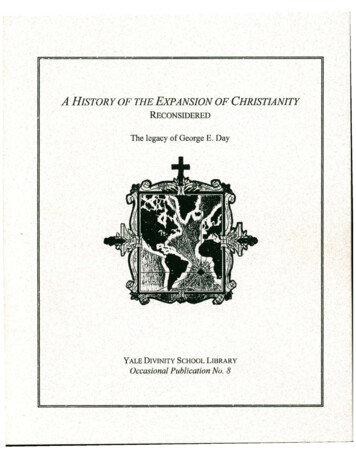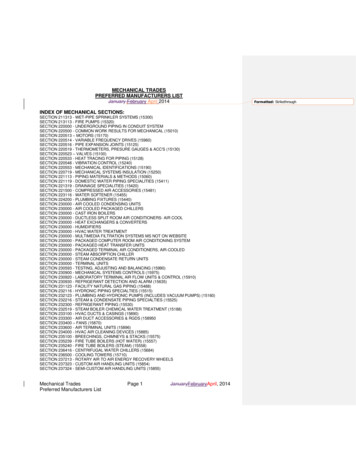
Transcription
A HISTORY OF THE EXPANSION OF CHRISTIANITYRECONSIDEREDThe legacy of George E. DayYALE DIVINITY SCHOOL LIBRARYOccasional Publication Nu. 8
YALE DIVINITY SCHOOLLIBRARYOccasionalPublicationNo. 8A HISTORY OF THEEXPANSION OF CHRISTIANITYRECONSIDERED.The legacy of George E. DaybyAndrewF. WallsNEW HAVEN, CONNECTICUTYale Divinity School Library1996
The Occasional Publications of the Yale Divinity SchoolLibrary are sponsored by The George Edward and OliviaHotchkiss Day Associates. This Day Associates' Lecturewas delivered at Yale Divinity School in June 1995, duringa meeting of the Yale-Edinburgh Group on the History ofthe Missionary Movement.
Kenneth Scott Latourette ( 1884-1968)Professor of Missions and Oriental History at Yale University, 1921-1953Author of A History of the Expansion of Christianity
A HISTORYOF THEEXPANSIONOF CHRISTIANl'(YRECONSIDEREDThe legacy of George E. DayA library, as Victor Hugo pointedout long ago, is an act of faith. It is a commitmentto anunseenfuture. In the first lectureo the Day LibraryAssociates,given in this chapel in the course ofthe first meetingof the Yale-EdinburghGroup on the Historyof the MissionaryMovement,Dr.StephenPetersoncelebratedthe visionof GeorgeE. Day.1 As a student at Yale, Day met the Amistadcaptiveswhose arrival in New Haven initiatedAmericanmissionsto West Africa. As ProfessorofHebrewhe assembledhere a specialistcollectionof publicationson missions. Peterson's lectureshowedthat Day's was an Abrahamicjourney,in which future generationswere blessed. Thebibliologicalacorn he plantedproducedin time a mightyoak. In taking up the high privilege ofdeliveringanother lecture in the Day LibraryAssociatesseries, I must, as a memberof the Universityof Edinburgh,rejoice to be doing so duringanothermeeting of the Yale-EdinburghGroup. And fortopic, it seems appropriateto turn to a work of scholarshipthat rests squarelyon the provisionsof thelibrarythat Day founded,and which is, perhaps, its most remarkablemonumentto date.The first volumeof A Hist01yof the Expansion of Christianity,by KennethScott Latourette,appearedin 1937; the seventhand final volumein 1945,just half a centuryago. In celebratingit, Irealize that in this audiencethere are colleaguesas well as successorsof Latourette,not to mentionsome of those select former studentsto whomhe was "Uncle Ken," and who testifyto his ongoinginfluence. I have no such claim; I can speak only as one of the many who have derivedrefreshmentand resourcefrom his writings,and especiallyfrom the seven volumesof the Expansion. Mine wasthe first student generationto have accessto the whole work. Not that my studentgenerationwasfallingover itself to do so; significantly,it was not from any of my teachersthat I learned of its
existence,but from a visitingpreacher, the dashingBishopofTirunelveli, Stephen Neill, during auniversitymission. The range of the book, its profusionof information,captivatedme. In time itscentral theme gripped me and helped to shape my own work; but long before that, as a teacherinAfrica, embarkingon serious studyof the then scarcelyregardedfield of African Christianhistory,Idiscoveredthe surprisingrichness ofLatourette's bibliographies. They were about as comprehensiveand as full as any one could get at that period. I did not yet know the secret of their source,thoughLatourettehimselfreveals it at the very beginningof VolumeI:For more than a quarter of a centurythe authorhas had the privilege of livingwith much ofthe pertinent literature. During most of that time he has had constant access to one of theworld's richest collectionsof printed materialrelated to the subject, in the librariesof YaleUniversityand especiallythe Day MissionsLibrary2In due course, I was able to visit the quarry from whence the Expansionwas hewn, and,indeed, the Day MissionsLibrarybecame a regular part of my life. This lecture,howeverunworthyinitself, is offerednot only in celebrationof the achievementofK. S. Latourette,by taking up themesdear to him, often with referenceto his own words and conclusions. It also acknowledgesa personaldebt to a wonderfullibrary and to a successionof librarians,curators, and library staffwhoseeffectivenessand helpfulnessare in my experienceunparalleled. Librariansas a race are the salt ofthe earth. Those connectedwith the Day Libraryexemplifythe traditionaluses of salt in superlativemeasure;they preserve the food of scholarship,and they enhanceits flavour.Latourette's Expansionas a MonumentalWorkNothing like Latourette's Expansionhad appearedbefore, and it has so far had no obvioussuccessor. Its scope, for a single author work, was extraordinary. It describes and documents,so faras the resources then availableallowed,the story of the Christianfaith in every century and in everypart of the world. Such exhaustivecoveragecan produce sentencesof almost comic intensity. Thus,2
summarizingreligious developmentsregionby region over the period 1914-1944,the author tells us,"Of Greenland. little need be said". This solemnstatementis then given solemnjustification.3Latourettedid not forget even remote islands. I once had an enquiryfrom a lady in Englandconcerninga Scottishancestorclaimedby familytraditionas the first Baptistmissionaryto St.Helena. I was surprised to hear of any Baptistmissionin that bastion of Anglicanrectitudein theSouthAtlantic,let alone a Scottishone. But a quick referenceto the Expansionrevealedthat suchwas the case, and even better, Latourettehad provideda reference.4 It was to a book publishedinNew York in 1852 describinghow a Scotwho had developedBaptistviews betookhimselfto SouthAfricaon his own initiative,and, afler an interimministryto convicts,mutino"1ssailors,and guanoliftersfound a niche in St. Helena. And, of course,the book was in the Day Librarywhere Latourettehimselfhad found it, and its subject's descendantwas able, to her delight,to get a xerox copy.Latourette'secumenicalvision is as remarkablefor this period as his geographicalrange.Indeed,it is identifiedas his distinguishingfeatureby the authorof a recent studyof Latourette,whodescribeshis theme as "Unity of all Christiansin love and mission."5 Latouretteseeks to describeChristianexpansionin such a way as to includeall those who have borne Christ's name; and he didthis long before mutualrecognitionbetweenCatholics,Protestants,and Orthodoxwas at allwidespread. It representedmore than conventionalcourtesyfor this evangelicalBaptistto beginVolume6 with a tribute to John J. Considine,of what he calls "the goodlyfellowship"6 of Maryknoll,for helpingto initiatehim into the ambienceof Catholicmissions.But Latourette'svisionhas deeper springs than a desire for even-handednessbetweentheconfessions: He is not writing Churchhistory,but Christianhistory. Churchhistorywritingrequiresecclesiologicalchoice; it assumes,consciouslyor unconsciously,a specificidentificationof theChurch,or at least a particularmanifestationof it. The various models of Churchhistoryteachingthathave been adoptedas classicalin the West are producedby accumulationsof essentiallylocal factors,3
which lead to certain selectionsof themes and certain proportionsin their treatment. Even volumeson "the historyof the early Church"do not alwaysmean what those words, taken literally,mightimply. Whatthey usually give is a selectionof themesfrom early Christianitythat are relevant to aparticularbody of Christianswith a particulargeographicaland confessionallocationtoday. (Notehow in Westerncurricula the Eastern Churchprogressivelytapers out after the christologicalcontroversies). The local nature of these modelsis revealedwhen - as, alas, is too commonlythe case- they are absorbed unchangedinto curriculaintendedfor Africa or Asia. What then often happens isthat materialabout African and Asian Churchhistory is simplystitched on the end of materialoriginallyconceivedfor a Westernpurpose. Studyof Church history in Africa and Asia requires aprocess of thoroughreconceptionand re-selection. There is no fixed nonnative corpus of Churchhistoryto which additionsand updatingscan be made. The end shapes the beginning. If the end is tounderstandthe place of Christianityin modem India or Nigeria or Uruguay,or even in a global societyinvolvingall these places, the wholeof the studyof the Church even in its early phases has to be rethought.Latouretteseems to have recognizedthis principle. Because he wishedto studythe Christianfaith in relation to human history as a whole,he reconceivedits historical frameworkin a quitedifferentway from that in which Christianhistoryhad hitherto been presented. The contrastwith theusual view of early Church historyis manifestin his opening volume,coveringthe first five centuries.The averagestudy of early Christianityis concernedalmostentirelywith Christianityin the RomanEmpire. Latourette,of course, is also concernedwith the significantexpanse of early Christianityoutsidethe Roman Empire, in the MiddleEast, in Central and Southern Asia, in Eastern and NiloticAfrica. But he does more than widen the geographicalscope of the traditionalhistoryof the earlyChurch. He puts matters in perspectiveby pointingout how comparativelysmall a proportionof theworld's populationwas comprehendedwithinthe Roman Empire, and by carefullyintroducingthe4
two other contemporarypoliticalunits with which it bore comparison. He points to the PersianEmpire,with a differentand highlycomplexChristianstory, and the Han Empire of China. Here, aselsewhere,Latourette's short servicein China gaveproportionto his accountof other themes,just ashis work as a professorof Asian historyintertwineswith his work as a professorof missions. Hetalks, for instance,as few Westernhistoriansof his day would, in terms of a single Euro-Asiaticcontinent,of which WesternEurope (the focusof so much studyof Christianhistory)formsonly thefar tip. He interprets the emergenceof the characteristicforms of WesternChristianityin relation toits distancefrom the Mongoland Turkishincursions,the fact that the Scandinavianswere the lastmajor invadersfrom the land mass eastward. Perhaps the concept of China as the MiddleKingdominfluencedhim more than he knew.Still more interestingis his treatmentof the subjectmatter of early Churchhistory. No areaof early Christianhistory has receivedmore attentionthan that of Gnosticism,and perceptionsof ithave been radicallyrevised by the remarkablediscoveriesthat have taken place since the Expansionwas published. But when Latourettetreats Gnosticism,he does so in relationto his centraltheme ofChristianexpansion. This meansthat the crucial questionthat he asks about Gnosticismis, to whatextentdid the heavily acculturatedformsof Christianitythat make up what is todaycalled Gnosticismdraw people in Hellenisticsocietytowardsfaith in Christ? Were they more or less successfulthan theless heavilyacculturatedformsusuallycalled "catholic"? His answer, as usual, is not straightforward;it is sometimesmore and sometimesless. Gnostic,Arian, Montanist,Donatist,Nestorian,Jacobite,aswell as those forms of Christianitydenominatedorthodox,are each examinedin terms of theirmissionarysignificanceand effect.7 The only generalizationLatouretteallowshimselfis that it wasthose groups that most clearlymaintainedthe centralityand ultimate significanceof Jesus Christthathad the most durable effect. The sameprinciplesappliedto later centuriesensure that he gives equalattention,so far as the availableresourcesallowhim ("of Slavic languages[I have] used onlys
Russian",8 he admitsmodestly),to Catholic,Protestantand Orthodoxactivityin Christianexpansion.He does not ignore the Reformation,but he treats it in a quite differentway from the standardChurchhistories,whether.Catholicor Protestant,of the period. His viewpointis indicatedin the explanatoryrubric attachedto chapter one of Volume3 where the Reformationperiod is described as: "TheRevival in Western Christianityexpressingitself through the rise of Protestantismand the RomanCatholicReformation."9 The languageis significant,for, as we shall see, he did not interpret"expansion"in terms of crude statisticalincrease. How Latourettewould have revelled in thematerialsthat would have been open to him today, in the multitudinousindigenouschurchesof Africa,the base ecclesialcommunitiesof Latin America,the extra-churchand non-churchmovementsofAsia, the diverse embodimentsof Christianityin his beloved China, the house churches of the West,and the explosionof evangelicalcharismaticand Pentecostalcommunitieseverywhere. But he livedin an age when everyoneassumedthat Christianityexisted in three distinctmodes, Catholic,Protestant,Orthodox. In our day we are realizingnot only that there are substantialcompaniesofChristiansthat do not fall into any of these categories,but also that the terms themselves,reflectingasthey do the religious and culturalhistoryof the West, are increasinglyunhelpfulas terms ofdescriptionor analysis,even if they retain significancein terms of connexionand organization.Historiographysince LatouretteIt goes without sayingthat the researchesof fiftyyears have transformedthe possibilitiesforthe studyof Christianexpansion. The transformationis particularlymarked with regard to whatLatourettecalled The Great Century,the nineteenth,to which he devotedthree of his volumes,and tothe first half of the twentiethcentury,subjectof part of his seventhvolume. For these periodsLatourettehad to rely largelyon printed missionsources. Since his time, much fundamentalresearchhas been conductedon the primarysources,oral and written, and new perspectiveshave been taken6
up in which Afiicans,Asians,LatinAmericansfigure as the principalagents of Christianexpansion.Such resources were not availableto Latourette,and he is untroubledby the questionsabout therelationshipof missionaryhistoryand Churchhistorythat his successorshave to face. Nevertheless,he is aware of other basic issues in the phil osophyof history,and he is consciousof a tension indealingwith them. As a Christian,he believesin a divine purpose for the world behindhistory. He isalso by instinctand training a post-EnlightenmentWesternhistorianfor whom such factorsshouldplay no part in historicaldiscourse.10 Latourettenever resolves this tension. He meets it by openlyconfessinghis Christianfaith while in his historicalanalysisconscientiouslytryingto act as a postEnlightenmenthistorian. The nature of his subject,however,from time to time calls him to makegeneralizationsabout Christianhistory,and thus to commenton the nature of Christianityas displayedin its history. Such statementsfall to be examinedby historiansand theologiansalike; and I suspectthat Latourette's generalizationshave barely satisfiedeither group. He made no claim to being atheologian,and his theologicallanguagesometimessounds naive as well as dated; and theologians,for whom teleologicalquestionsabout historyare primary,have not taken him particularlyseriously.In this lecture I want to treat the Expansion not simplyas a chroniclewith bibliographies,but as awork of generalizationand synthesisabout the Christianfaith. I wish to suggestthat the theologicalimplicationsof the accountthat Latourettegivesneed to be taken much more seriouslythan hissometimessimplistictheologicallanguagemight suggest.Three Tests of Christian ExpansionOne way of approachingthe topic is to examinejust what is meant by the expansion ofChristianity. We have noted that Latouretteeschewsany ecclesiologicalor institutionaldefinitionofChristianity;he will not identifyit with any particularchurch or group of churches. At the same timehe attemptsno definitionof the type that mightbe used in the phenomenologyof religion. At one7
point he seemsto paraphrasehis title as "the spread of the influenceof Jesus",11 bringingdownthewrath of ReinholdNiebuhr,who detectedin the Expansion an underlyingsecularliberalview ofprogress,and a tendencyto appropriateto the influenceof Christwhat were reallythe productsofsecular influences.12 But Latourette'sparaphrasehas certainhelpfulfeatures. In the first place, itremindsus of the distinctivecharacterof Christianfaith:Christianityis about Christ. In the secondplace it implicitlydistinguishesChristfrom the communitythat bears his name. The witnessof theChristiancommunityto Christis, as Niebuhrhimselfinsisted,constantlyambiguous. Vital as thechurchmaybe as a vehicleof Christ's influence,it is stultifyingto identifyits influencewith his. Noone is saved throughChristianity- thoughit may be possibleto be damnedthroughit.But Latourettelater becomesmore specific,and proposes a three-foldmeansfor measuringthe influenceof Christ- that influencewhich is the sourceof Christianexpansion.13 The first is thespread of Christianprofessionin particularareas. The secondis the number and strengthof newmovementsowingtheir originto Christ. The third is what he calls "the effectof Christianityonmankindas a whole." One Englishreviewerof the Expansion describesthese as "non-ecclesiastical,undogmatictests, of a kind rather uncongenialto the main traditionof WesternChristendom",14 whichI take to be an Oxfordway of sayingthat they are more or less what one mightexpectfrom anAmerican. In fact, I suggest,on close examination,each of these tests of Christianexpansionis seento be highlytheological,with implicationsthat can be clusteredround a series of New Testamentthemes. I do not presumeto interpretLatourette'sown mindhere, nor is what followsto be seen asattJ.ibutableto him,even when it arises out of his words. It is temptingto add to his threefoldanalysisa furtherdimensionof expansion:the expansionof the Christianfaith by its interactionwith differentculturesand even languages,so that by cross-culturaldiffusionit becomes a progressivelyricherentity. This processhas been exemplifiedabundantlysince Latourette'sday, for over that timeChristianityhas passedfrombeing a mainlyWesternto a mainlynon-Westernreligion. But such a8
themeneeds fullertreatmentthan can be givenhere, and it seemsprudentto restrictdiscussiontoLatourette'sown three statedcriteria.The Church TestThe first of these,it will be remembered,is the spreadof Christianprofessionin particularareas. This is the easiestof the three to apply,for in principle,if not alwaysin practice,it relates tosomethingthat can be counted. In our own dayDavidBarrett's World Christian Encyclopediarepresentsthe mostthorough-goingattemptat countingChristiansyet undertaken.uIt is clearthat there are times andplaces whenlarge numbersof peoplenewlyprofessallegianceto Jesus Christand formnew Christiancommunities.And it is equallyclearthat at othertimes and in otherplacesthis processstagnatesor goes into reverse;wherethosenewlyprofessingallegianceto Christare few and where the communitiesof his worshippersdwindleand die away.This themeis fundamentalto Latourette'sconstruction,his patternof Christianadvanceandrecession.This firstmark of Christianexpansionshouldnot lightlybe dismissedas a "nonecclesiastical,undogmatic"category,even by the mostexactingtheologian,for it leadsdirectlyto theNew Testamentthemeof the Church,the wholepeopleof God. The first sign of the expansionof theinfluenceof Christis the presenceof a communityof peoplewho willinglybear his name,an "Israel"that maintainshis worship. The other tests themselvespresupposethis one, the existenceof Christiancommunity,howeversmall.In consideringthe primacyof the Churchfactor,it is worthrememberingthat the first effectof Christianexpansionis not the productionof savedor enlightenedindividuals,but of congregations.Unless it be the Ethiopianeunuch(and evenhe musthave had someinstitutionalformof worshipofthe God of Israelback home,or whatmotivatedhis journey?)it is doubtfulwhetherthe New9
Testamentprovides a single exampleof an individualconvert, a "saved individual"left to ploughhislonelyfurrowwithoutfamilyor congregation.The influenceof Jesus not onlyproducesgroupresponse;it works by means of groups,and is expressedin groups. The influenceof Jesus, that is,operatesin terms of social relations.The early days of the modem missionarymovementsoon revealedthe impossiblepositionofthe individualconvert. The Missiona,y.Register for July 1820, for instance,publishesthe followingletter, addressedto the AssistantSecretaryof the ChurchMissionarySociety:Dear ReverendBrotherI am just told I goingto leaveyou, day after tomorrow. I will thereforewrite you,Dear SirI go home tell my countrymen,that Jesus is the true God. Atua is false- no God, all nonsense.I tell my countrymen,Englishmenno hang his self, not eat a man - notattooing- no fall cuttinghis self. My countrymenwill say to me, "WhyEnglishmanno cut himself?"It tell them Book of Books say, "No cut- no hang no tattoo" I tell them "Jesus say all they that do so go to hell." I tell them they sin- they do wrong. I knowthat Jesus Christ's blood cleansethall sin. I tell my poorcountrymenso. He no find out the way to Heaven - poor fellow! Jesus our Lord,He found a way to Heavenfor all who know Him. I tell my countrymen,Christiansno fight, no use war club, no spear - they read Book of Books - alltrue! says, No fight, all love.I get home to New Zealand,and I go tell my countrymen,"Comecountrymen,into Houseof Worship,where true God is worshiped"I hope you farewell. Goodbye.Your affectfiiendThomasTooi 16Tui was a Maori of some significancein his home community. Like manyof his seafaring10
contemporaries,he had travelled,and in the courseof hisjourneysreachedAustralia. Therehe cameto the noticeof the Rev SamuelMarsden,colonialchaplainandzealouspromoterof missions,whosehigh hopes of the Christianpotentialof the Polynesianpeoplescontrastedwith his despairoverAustralianAboriginals. Tui stayedtwo years with Marsden,fullyconfirmingall the latter's hopes of abreakthroughfor the gospelin New Zealand,andresultingin Marsdenarrangingwith the ChurchMissionarySocietyfor Tui to spend a furtheryear in England. Tui's evidentconvictionand generaldemeanourduringhis staydelightedthe friendsof missions. Theedifyingletter was writtenon theeve of his return to New Zealand,and manymust havebeen waitingeagerlyfor the effectof histestimonyamonghis compatriots.Tui returnedwith Marsden. But a week afterhis returnhe was tellingMarsdenthat he couldnot stand his groundunless a Europeanjoined him. The onlywayhe knew of being a Christianwasthe Europeanwayhe had met in Australiaand England. Therewere no other Christiansin hiscommunity;the onlyway he couldsupporta Christianlifewas by maintaininga Europeanlifestyle- a"civil life,"Marsdencalled it, effectivelyoutsidehis community.It is hardlysurprisingthat hisattemptsoon broke down. In a few months,all that was left of the professionof Christianfaith and theyears of Christiantrainingwas a bluejacket. The glimpseswe get ofTui's later life in writtenrecordsindicateprowessas a warrior("the greatestprofligateand savageon the coast," accordingto oneEuropeanvisitor),and the last mentionof all refersto an attempteddeal by Tui with a Frenchseacaptain- tattooedhead in exchangefor a keg of gunpowder.17 Thereare plentysuch examplesof thetragedyof the loneconvert. Not the convert,but the congregationis the first sign of the influenceofChrist.The first test of the expansion,then, is the Churchtest; the emergenceof a worshippingcongregation.But in employingit, it is necessaryto take its frag lityinto account. It is manifestthatthe expansionof Christianitydoes not plant churchesthat endurefor ever. The first centreof11
Christianity,and one that saw rapid statisticalgrowth,was Jerusalem. The homelandsofTertullianand Augustineno longerburgeon with Christianscholarsand statesmen. In manyonce Christiancountries,fonner churcheshave becomemosques;in my own they have become garages andsometimesnightclubs. The Christianstory - and this, too, is fundamentalto Latourette's view - is not .a steady,triumphantprogression. It is a story of advanceand recession.Latourette'swhole arrangementof Christi nhistoryis based on this theme of advanceandrecession;the historyof expansionincludeswithin itself a historyof contraction. The rhetoricinwhich Latourettewas raised was one of Christiantriumphfrom age to age; the missionarymovementto which he himselfbelongedhad been in a hurry to bring it to completion. But Latourettethehistorianknew that the historydid not match the rhetoric;and, in a sectionnear the end of volume7,18he showsthat he is aware that Islamicexperiencehas been different.Islam can point to a steadygeographicalprogressionfrom its birthplace and from its earliestyears. And over all these years it has hithertonot had manyterritorial losses to record. WhereastheJerusalemof the apostleshas fallen, the Mecca of the Prophetremains inviolate. When it comestosustainingcongregationsof the faithful,Christianitydoes not appear to possess the same resilienceasIslam. It decays and withers in its very heartlands,in the areas where it appears to have had theprofoundestcultural effects. Crossingculturalboundariesit then trucesroot anew on the marginsofthose areas, and beyond. Islamicexpansionis progressive;Christianexpansion is serial.Do the resilienceof Islam and the vulnerabilityof Christianityreflect somethingof theinherentnature of the two faiths? Does the very freedomof response inherent in the ChristianGospelleave it open to ultimaterejection? Is the Christianimpact only durable when there is sustained,neverceasingpenetrationof the host culture? Christianityhas no culturallyfixed element,as is providedbythe Qur 'an fixed in heaven,closed traditionson earth, perfectionof law in shari 'a, single shrine inMecca, and true word everywherein Arabic. If the acts of cultural translationby which the Christians12
of any communitymake their faith substantialwithinthat communitycease - if (if one may use suchlanguage)the Word ceases to be made flesh withinthat community-the Christiangroup within thatcommunityis likelyto lose, not just its effectiveness,but its powers of resist ce. Most cultures are infrequentchangeor encounterwith others,so the process of translationis endless.It is not profitableto moralizeon the fate of vanishedchurches;to do so is like claimingtoknow that those on whomthe Siloamtower fell were Jerusalem's chief sinners. We do not, cannot,know why the candlestickis taken from its place. But the New Testamentis clear that God candispenseeven with self-importantChristiancommunities,and that He dependson no singleinstrument.The Churchtest of Christianexpansionis thereforea provisionalone. New churches,orchurchesin new areas, are not gains to be plotted on the map. That is an Islamic,not a Christianviewof expansion. Such churchesare simplypositionsthroughwhich the influenceof Jesus Christ maycome to bear on people and communities.The KingdomTestThere are other reasonswhy the Churchtest on its own is not a satisfactorymeasureof theinfluenceof Christ. There may be manyelements'in the actual local expressionof Christianityat anyone time that cannot be remotelytraced to him. And yet within the same communitythat bears theChristianname there may be groups of believersstrivingto respond to him, tryingto find a way oflifethat more nearlyreflectshis, to bring his life and teachingto bear more radicallyupon their churchand society. This brings us to Latourette'ssecondtest of Christianexpansion:the numbers andstrengthof new movementsowing their origin to Jesus Christ. This was his rough and ready way ofmeasuringthe depth of Christianexpansionat any one time in any given area. Clearly,he thoughtthatthe test of the local strengthof Christianitywas whetherit was radical and innovative. Once more, I13
suggest,the simplisticappearanceof his criterionis deceptive;and, thoughthe criterionmay seem atfirst sightto be a sociologicalone, it is highlytheological.Latourette'ssecond test in fact is a Kingdomtest; it standsfor the signs of the KingdomofGod. The Kingdomshines.inthe Churchand exerts its energywithinand beyondit, yet cannotbeidentifiedwith it. The Kingdomof God, the Gospelstell us, is sproutingseed, growingin secret andsuddenlyburstinginto flower. The Kingdomof God is fennentingyeast,that stirs things up so that alittleof it transformsthree wholemeasuresof meal. The Kingdomof God is declaredwhen demonsarecast out by the finger of God. The Kingdomof God has drawnnear in the.presence of Christwithbis acts of mercyand power.Kingdomsigns like these mark the innovativenew movementsthat reflecttrue Christianexpansion. Because,like the Kingdom,they sprout and stir up, they produce a more radical Christiandiscipleship.Because,like the Kingdom,they can transfonnthe wholebasin of meal into yeastybread, theybring the Spirit of Christto bear more widelywithintheir society- penetratingthatsociety'sculturemore deeply,translatingChrist into that societymore perfectly,makingthe Wordfleshwithinit. Because,like the Kingdom,they stand for the castingout of demons,and becausethedemonsthat blight our world are legion,they have a multitudeof specificobjects and effects.The archetypeof the movementsthat the Kingdomtest reveals as the agentsof Christianexpansion,is the great prophet of the Kingdom,John the Baptist,with his call to God's people for achangeof heart, for radicalrighteousness,his revealingof a day of crisis and decision. It is probablethat John did not inventthe rite that gave him his nickname. The new thing he did was to take theceremonythat markedthe entranceof a pagan convert into Israel, and insist that it applied also to thebirthrightpeople of God. The people of God needed repentanceas much as anyonein the paganworld. "You must be born again," says Jesus, taking up the sametheme.19 "You" is plural here - notso much,surely,Nicodemuspersonally,as "you people," the leadershipof the congregationof God's14
people that Nicodemusrepresented. You must start again,with repentancefor the past and God'sSpirit for the future,if you are to begin to know the Kingdom,and what it really means to be what
Author of A History of the Expansion of Christianity . A HISTORY OF THE EXPANSION OF CHRISTIANl'(YRECONSIDERED The legacy of George E. Day A library, as Victor Hugo pointed out long ago, is an act of faith. It is a commitment to an unseen future. In the first lecture o the Day










